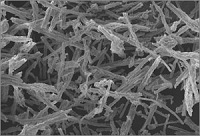 |
| Mesoporous silica rods spontaneously assemble to form a porous 3-D scaffold. Courtesy of Wyss Institute at Harvard University |
Researchers at the Wyss Institute for Biologically Inspired Engineering at Harvard University and Harvard's School of Engineering and Applied Sciences have demonstrated that a nonsurgical injection of programmable biomaterial can assemble in vivo into a 3-D structure to attack cancer cells and help to prevent other infectious diseases such as HIV.
According to the study authors, silica-based biodegradable rodlike structures called mesoporous silica rods (MSRs) can be loaded with biological and chemical drug components and delivered by needle underneath the skin. The rods then assemble at the vaccination site to form a 3-D scaffold complete with porous spaces large enough to recruit and fill with dendritic cells. The dendritic cells monitor the body and trigger an immune response against harmful cancer cells and infections.
Once the scaffold has recruited dendritic cells, the contained drugs are released to activate an immune response. The dendritic cells then leave the scaffold and travel to lymph nodes, raising the alarm and directing the body to attack specific harmful cells. The treatment has only been tested in mice but was found to be highly effective, researchers said.
The MSRs are synthesized in a lab and built with small holes, known as nanopores, which can be filled with cytokines, oligonucleotides, large protein antigens or any of a variety of drugs to treat a range of ailments. The findings were reported in Nature Biotechnology.
"Although right now we are focusing on developing a cancer vaccine, in the future we could be able to manipulate which type of dendritic cells or other types of immune cells are recruited to the 3-D scaffold by using different kinds of cytokines released from the MSRs," said co-lead author Aileen Li. "By tuning the surface properties and pore size of the MSRs, and therefore controlling the introduction and release of various proteins and drugs, we can manipulate the immune system to treat multiple diseases."
The researchers say the manufacturing is easy and rapid, so the vaccines could potentially be widely available quickly to fight an infectious disease. Their injectable nature would make them easy to administer both inside and outside a clinic, added lead author David Mooney.
In addition to disease treatment, the method could be used proactively by building an immune response prior to infection.
"These injectable 3D vaccines offer a minimally invasive and scalable way to deliver therapies that work by mimicking the body's own powerful immune response in diseases that have previously been able to skirt immune detection," said Wyss Institute Founding Director Dr. Donald Ingber.
- read the release
- and here's the abstract